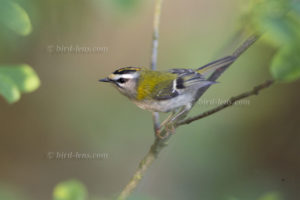 You are in a coniferous forest and you hear a high “ziziziziit”, practically always on the same pitch. You cannot go wrong in this combination. Singing is the hallmark of the Firecrest (Regulus ignicapilla). If you have discovered the Firecrest e.g. by imitated the “singing”, you quickly see a bright orange-red crest, which is raised when excited. Both sexes have a black eye stripe and a large olive-yellow spot on the sides of the neck in front of the wing bow;
You are in a coniferous forest and you hear a high “ziziziziit”, practically always on the same pitch. You cannot go wrong in this combination. Singing is the hallmark of the Firecrest (Regulus ignicapilla). If you have discovered the Firecrest e.g. by imitated the “singing”, you quickly see a bright orange-red crest, which is raised when excited. Both sexes have a black eye stripe and a large olive-yellow spot on the sides of the neck in front of the wing bow;
The Firecrest is like the Goldcrest (Regulus regulus) a lightweight. It is a pleasure to find a Goldcrest near tall conifers. The Goldcrest is only about nine centimeters tall. It is the smallest bird in Europe. It is very vocal and its reputation is fine and very high. The Goldcrest likes to be in the treetops and bounces and jumps restlessly between the spruce branches. In contrast to the Goldcrest, which looks almost identical, the Firecrest has a wide white stripe over the eyes.
Firecrests search and peck their food off branches more superficially. Sometimes branches and leaves are whirled around. Firecrest must feed about their own body weight each day. That’s why you see them constantly looking for food. In contrast to the somewhat more resistant twin species, the Firecrest largely leaves the breeding areas during winter. It is less tied to spruce than the Goldcrest and uses coniferous trees as well as deciduous trees.
During autumn you can get confused. The Yellow-browed Warbler (Phylloscopus inornatus) appears as a not so rare vagrant in middle Europe at the beginning of October. The Yellow-browed Warbler is a typical Phylloscopus – warbler with a fine, pointed beak and a relatively short tail. In appearance, this Phylloscopus actually resembles a Firecrest very much. Depending on how it is positioned, it does not look more delicate than the domestic Common Chiffchaff (Phylloscopus collybita), although its body length is eight millimeters shorter. The top is olive green with a slightly lighter rump and upper tail quilts. Two distinct but differently pronounced wing bars, which are caused by the light hems on the secondaries, are usually the most striking feature. The top of the head is dark green with a very lightly indicated lighter parting on the crown. The green-yellow streak of the eyes gives its name. This eye stripe extends far back and is delimited at the bottom by a black eye stripe.
Where forest damage occurs, Firecrest quickly get problems: the thinned out branches no longer offer them sufficient protection and the food supply is severely limited. While many birds benefit from the increasing structural diversity after forest damage, this does not apply to the Goldcrest. For example, Eurasian Wryneck (Jynx torquilla), Tree Pipit (Anthus trivialis) and Eurasian Bullfinch (Pyrrhula pyrrhula) are birds prefer disturbed areas inside forests (e.g. after a forest fire) and use these more open areas as a breeding territories. The buzzing song of the Common Grasshopper-Warbler (Locustella naevia) cannot be heard in a closed forest, too.
To cope with the growing demand for top shots of the species of the Palearctic, Bird-Lens is keen to enrich the range of pictures of birds not only in the western Palearctic. Trips around the home range or to remote places to capture images were very successful. The nice image of the blog is only a first impression, what you will find in the gallery in the “Picture Shop” very soon. Just give bird-lens.com a message, if www.bird-lens.com could serve you with an image needed before the new pictures are online.